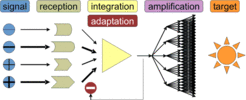The Signal Transduction Cascade
Signal transduction is defined as the response of a cell to the application of an external stimulus. Stimuli can be chemical or physical, typical examples being light, oxygen, nutrients, hormones.
Signal transduction always involves the following phenomena:
-
signal reception
-
integration
-
amplification
-
a target that is affected

Fig. 1: the principle components of a simple signal transduction casca
The following modules are involved in signal transduction:
- a receptor of the stimulus
- (Description of a procaryotic signal reception module)
Receptors need a receiver domain (e.g. a ligand-binding domain for chemotaxis, or a light-absorbing chromophore in phototaxis). Their activation is forwarded by a transducer protein that contains a signalling domain. The architecture of receptors and transducers is as heterogenous as the perceived signals. The receiver and signalling domain may be present in distinct proteins that form a complex or may be fused in a single polypeptide chain. While the signalling domain functions inside of the cell, the receiver domain is frequently on the outside. Consequently, the receptor/transducer is located in the membrane. - a signal transduction chain or a signal transduction network
responsible for amplification, integration, and adaptation (see below) - The simplest transduction chain is that of the two-component systems of procaryotes.
- A typical network are the phosphorylation cascades of the Map kinase pathway in eucaryotes.
- a target that is affected and produces the cellular response
Typical targets are: - the genome
This results in regulation of gene expression. - the cytoskeleton in eukaryotes
- the flagellar motor in prokaryotes
This results in directed movements due to a "biased random walk".
The signal transduction chain (or network) is responsible for
- integration
- Integration indicates that several receptors activate/deactivate one and the same catalyst which thereby acts as a signal integrator.
- In eucaryotic signal transduction networks, cross-talk between different systems adds another level of integration.
- amplification
- Amplification typically consists of activation of a catalyst, such as a protein kinase, which amplifies the input of a single unit (photon or molecule) into the phosphorylation of many target molecules.
- adaptation
- Adaptation is defined as return of the signalling system to the pre-stimulus level while the stimulus persists. This enables cells to perceive changes in stimulus size rather than absolute stimulus levels.
- Example: Adaptation of the eye to bright sunlight or dim moonlight.
Keywords: signal transduction, chemotaxis, phototaxis, reception, amplification, integration, adaptation, receptor, transducer, two-component regulatory system, protein kinase, histidine kinase, response regulator
